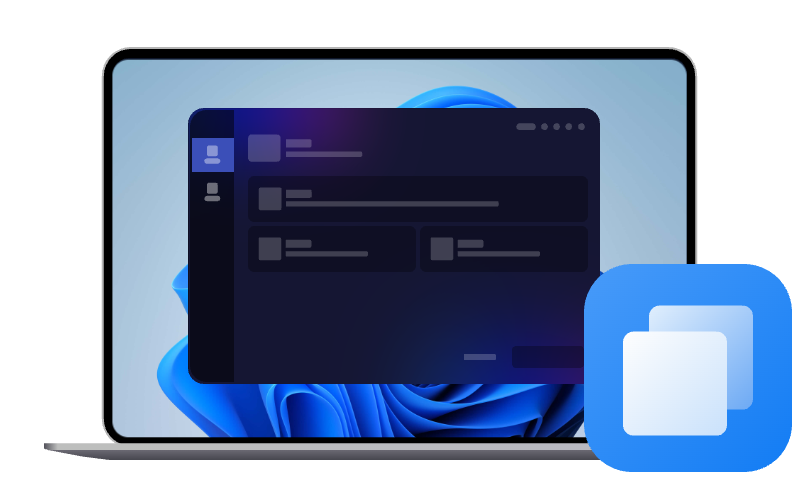[SOLVED] Windows Server C Drive Full for No Reason
If you are experiencing the Windows Server C drive full issue, scroll down to learn the possible causes and how to fix it in the short and long term.
That frustrating "Low Disk Space" warning on your C: drive is something many users face. When your cdrive gets full, your computer slows down, programs crash frequently, and you may even be unable to save important files.
But don't worry,you don't need to be a tech expert to fix it. This guide will show you simple, safe steps to free up space, find what's taking up room, and keep your computer running smoothly going forward.
What's Filling Your C Drive?
The easiest way to see what's eating your space is with a disk analyzer tool, such as TreeSize Free(recommended) or WizTree - both free and fast. Simply run as Administrator and select your C: drive. Within seconds, you'll see folders sorted by size - with the largest ones displayed right at the top. Here are the usual suspects causing Windows Server C drive fulls:
- 1. Windows Temporary Files. It may gradually accumulate over months of use and be located in the C:\Windows\Temp and C:\Users\[YourName]\AppData\Local\Temp.
- 2. Download Folder. We often download files and forget about them. Please check C:\Users\[YourName]\Downloads.
- 3. System Restore Points. Windows automatically creates system restore points, especially when you make significant changes. These restore points can take up over 10 GB.
- 4. Application Caches. Programs like Spotify, Photoshop, and game stores temporarily store data, which is often hidden in the AppData folders.
- 5. Duplicate Files. Multiple copies of photos, documents, or videos you forgot about.
Windows Server C Drive Full | Immediate Safe Cleanup
If you receive the "Low Disk Space", follow these safe cleanup to free up space quickly without damaging your system.
#1: Clean Up C Drive with Disk Cleanup
1. Press Win + S, type Disk Cleanup, and select Run as Administrator.
2. Select your C: drive and click OK.
3. Check these safe-to-delete items and click Apply > OK.
- Temporary files
- Windows Update cache
- System error memory dumps
- Recycle Bin (if you're sure you don't need anything in it)
- 📢Important Tip: Click "Clean up system files" to access even more space. This reveals large items like previous Windows installations that can free up significant space.
#2: Clear Browser and Application Caches
Your web browsers and applications store temporary data that can grow to several GB, so you can follow the following path to clear caches.
- For Microsoft Edge: Go to Settings > Privacy, search, and services > Choose what to clear.
- For Google Chrome: Go to Settings > Privacy and security > Clear browsing data.
After accessing the path, select "Cached images and files" and clear data from "All time"
#3: Move System Files to Another Drive
Two hidden system files can consume massive space, but never delete these files directly. Instead, you can change the location of hiberfil.sysand pagefile.sys files.
- hiberfil.sys - used for hibernation (can be several GB)
- pagefile.sys - virtual memory file (often 4-8GB)
1. Go to Settings > System > About > Advanced system settings.
2. Under System Properties, click Settings under Advanced.
3. Click Change under Virtual memory and select another drive with space. You can then move the pagefile there.
#4: Check Users Folder for Large Files
Users folder may contain large files, causing Windows Server 2012/2016/2019/2022/2025 C drive full. To fix the Windows Server C drive full issue, you can choose to find them and save to a safe location.
- C:\Users\[YourName]\Downloads
- C:\Users\[YourName]\Pictures
- C:\Users\[YourName]\Music
- C:\Users\[YourName]\Videos
- C:\Users\[YourName]\Documents
#5: Empty Temp Folder
Temp folder may be another location taking up much space, especially for users running numerous background applications. Just disable unnecessary apps and remove all files from Temp folder.
1. Go to Settings > Privacy >Background apps and disable Windows store and some other unnecessary apps.
2. Type %temp% and press Enter to access the Temp folder. You can then check files you don’t need.
3. Once confirm, select them and click Delete.
#6: Uninstall Unnecessary Apps from C Drive
Some applications that take up a lot of space but are not frequently used must be uninstalled to free up storage space.
1. Press Win+R, type Control Panel and select it to access.
2. Click Uninstall a Program under Programs.
3. Locate the program you want to uninstall, choose Uninstall and follow the uninstallation wizard to complete it.
When to Extend C Drive in Windows Server?
Sometimes, simply cleaning up the C drive isn't enough, as the space may quickly fill up again. This time, you need to extend C drive for large space. Here are two common solutions:
- Extend C drive with free space if your current drive has.
- If not, clone C drive to larger drive.
#1: Extend C Drive with Free Space in Disk Management
Disk Managementis the built-in tool for Windows Server to managehard drives and partitions. It lets you perform essential tasks like extending partitions, creating new volumes, and assigning drive letters. It serves as the preferred partition management tool
1. Click Start, then select Server Manager.
2. In the navigation pane, expand Storage, then select Disk Management.
3. Right-click on the C: drive and select Extend Volume.
4. Select the available disk space and follow the Extended Volume Wizard's instructions to complete the process.
#2: Clone C Drive to Larger Drive using AOMEI Cloner
AOMEI Cloner is a reliable Windows Server cloning software that can clone C drive to larger drive in Windows Server 2008, 2012, 2016, 2019, 2022, 2025, etc., with a secure boot. Here are some highlights of it:

- Cloning any types of OS disks, e.g., HDDs/SSDs, MBR/GPT, SATA/M.2/NVMe/PCIe, etc.
- Clone OS to larger drive without unallocated space left.
- SSD Alignment for high performance.
- Bootable clone Windows Server and PCs.
1. Connect the new hard drive to your computer and be sure it’s recognized. Open AOMEI Cloner after cloning, and click Clone > System Clone.
2. Select the new, larger drive as the target drive. This software will select OS and boot-related partitions automatically.
3. The Make full use of disk space option is checked by default to optimize capacity. Be sure to check SSD Alignment for best performance (if it’s an SSD) and click Start Clone to clone OS to larger drive.
⚠️Note: Sector by Sector Clone is a cloning mode that can clone all sectors of a drive, including empty sectors and bad sectors, and takes longer.
After cloning, it’s necessary to perform a boot test and ensure the cloned drive is bootable.
- Shutdown your computer completely. Unplug the power cord.
- Remove the back cover using a screwdriver.
- Locate and unscrew the screws securing the original drive, then carefully remove it.
- Install the new, larger drive in the primary slot, and reassemble the device. Then, restart your computer to boot from the cloned drive.
Conclusion
With the above methods, you can temporarily solve the Windows Server C drive full issue. In the long term, it will be a wise choice to extend C drive to larger capacity with Disk Management (provided the current disk has sufficient space), or clone C drive to larger drive using a reliable cloning software.

